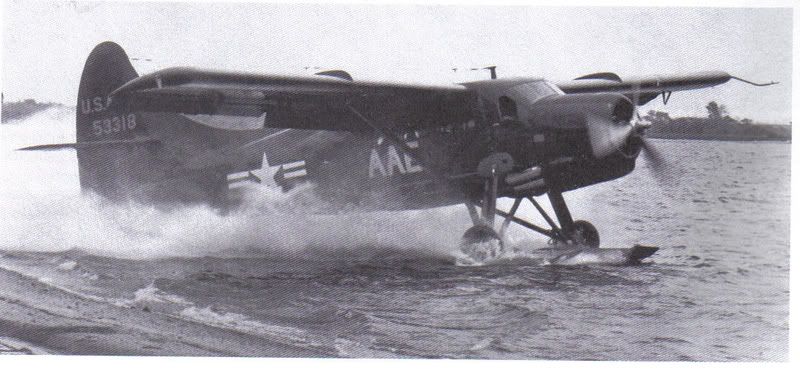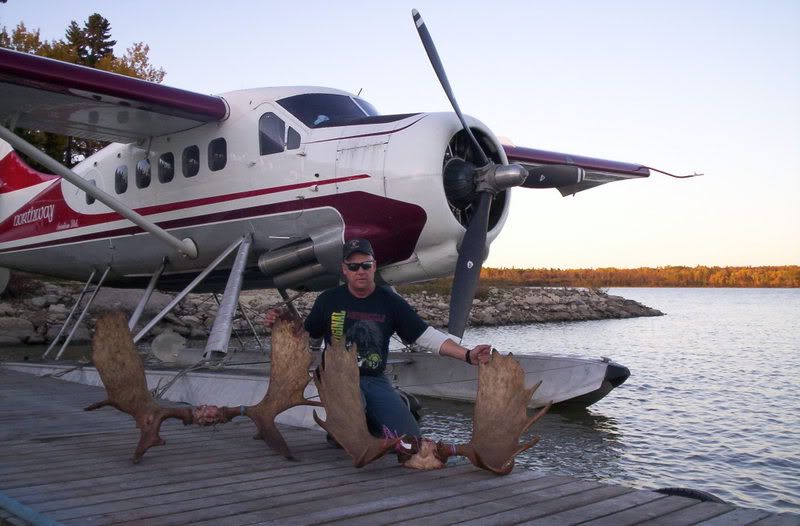Tuesday, March 31, 2009
Steve's "Otter Of The Week"! .....by Karl E. Hayes
U.S. Army "Vet", served in the "National Guard", trained "missionary pilots", then "perished" during "civilian life", this Otter has a fine "service history".
All information is from Karl Hayes' "masterful" CD entitled:
De Havilland Canada
DHC-3 OTTER
A HISTORY
CONTACT KARL, CD PRICING and ORDERING INFO - De Havilland DHC-3 OTTER - A HISTORY by Karl E. Hayes
----------------------------------------------------------------------------
Otter 291
Otter 291 was delivered to the United States Army on 30th October 1958 with serial 58-1685 (tail number 81685). It was allocated to the 12th Aviation Company, Fort Sill, Oklahoma. In August 1961 it flew north to Alaska when the Company was re-assigned there to join Yukon Command. 81685 was based at Fort Wainright, Fairbanks with the 12th Aviation Company and continued to fly with the Company until June 1967, when it went to the 568th Transportation Company, also based at Fort Wainright, to be prepared for service with the National Guard.
In January 1968, 81685 was assigned to the Alaska National Guard, based at Bethel. It was painted in a silver/red colour scheme with “ALAS-NG” on the tail. It flew in support of the 2nd Scout Battalion and operated on floats during the summer months and on wheel-skis in winter. It was joined at Bethel by 76131 (276) in June 1971, and in October 1971 both of these Otters flew south into retirement at the Military Aircraft Storage and Disposition Centre (MASDC), Davis-Monthan AFB, Tucson, Arizona. 81685 was allocated inventory code UA002 and 76131 was allocated UA003. They were two of five US Army Otters to be placed into storage at MASDC.
81685's period of storage in the desert 'boneyard' was not long. In October 1972, together with 53315 (179), another of the Army Otters in storage, it was allocated to the School of Bible and Music, Grand Rapids, Michigan. Vocational schools such as this were authorised to receive surplus military equipment. The School, which had recently opened an aviation section to train pilots and mechanics who would work in the field of missionary aviation, took full advantage of this entitlement, and received the two Otters and also four Beavers. These aircraft were flown from Davis-Monthan AFB to a small airfield at Fremont outside Grand Rapids, Michigan where they were civilianised and made ready for use by the School. 53315 was registered N432GR and 81685 was registered N433GR, the 'GR' of the registrations standing for Grand Rapids.
Unfortunately N432GR was damaged in a storm while at Fremont and it was decided not to repair it. It was trucked to Newaygo Airport outside of Grand Rapids, where the School's Aviation Division was based and over the following years, it was used for maintenance training and parts were taken from it to keep the other Otter flying. N433GR however was civilianised and entered service with the School, based at Newaygo Airfield and used for pilot training. Of the four Beavers which the School had received, two were used as ground instructional airframes and two were used for flying training, and were also in use to transport small music groups from the School around the country, even as far south as Florida. The Otter was considered too expensive for such a task and was only used for pilot training. Many of the pilots who trained at the School went on to become missionary pilots in under-developed countries. In 1978, due to rising fuel costs, the School decided to sell its Beavers and Otters, which were replaced with more economic Cessna 172s and 182s, better suited to the training role. Otter N433GR was sold to Yute Air Alaska and set off for its new base at Dillingham, Alaska. It joined the Yute Air Alaska fleet, which comprised several single Cessnas and Pipers, a Navajo, a Widgeon and an Evangel 4500.
Alas, the Otter's time with Yute Air Alaska was not long. It was destroyed in the course of an air taxi passenger flight near Togiak, Alaska on Sunday 3rd August 1980. N433GR had flown from Dillingham to Togiak, a forty minute flight, and was returning from Togiak with the pilot and nine passengers on board when the crash occurred. In a “continued VFR flight into adverse weather conditions” type accident, the pilot flew into a valley but lost visual contact due to heavy fog. He endeavoured to reverse his course, but in the attempted climbing turn, flew into a hill. The Otter crashed and burned, killing one passenger and seriously injuring two others. Six others were treated in hospital for minor injuries. N433GR was totally destroyed.
- by Karl E. Hayes
---------------------------------------------------------------------
Unfortunately, when there is a case of "aircraft vs. mountain", the aircraft is always the "underdog". Unbelievable that people survived this crash, a testament to the Otter's "robustness"..........

- 81685 formerly of the Alaska Army Guard in storage at Davis-Monthan AFB, Arizona August 1972 (Arnold Booy)
CONTACT KARL, CD PRICING and ORDERING INFO - De Havilland DHC-3 OTTER - A HISTORY by Karl E. Hayes
All information is from Karl Hayes' "masterful" CD entitled:
De Havilland Canada
DHC-3 OTTER
A HISTORY
CONTACT KARL, CD PRICING and ORDERING INFO - De Havilland DHC-3 OTTER - A HISTORY by Karl E. Hayes
----------------------------------------------------------------------------
Otter 291
Otter 291 was delivered to the United States Army on 30th October 1958 with serial 58-1685 (tail number 81685). It was allocated to the 12th Aviation Company, Fort Sill, Oklahoma. In August 1961 it flew north to Alaska when the Company was re-assigned there to join Yukon Command. 81685 was based at Fort Wainright, Fairbanks with the 12th Aviation Company and continued to fly with the Company until June 1967, when it went to the 568th Transportation Company, also based at Fort Wainright, to be prepared for service with the National Guard.
In January 1968, 81685 was assigned to the Alaska National Guard, based at Bethel. It was painted in a silver/red colour scheme with “ALAS-NG” on the tail. It flew in support of the 2nd Scout Battalion and operated on floats during the summer months and on wheel-skis in winter. It was joined at Bethel by 76131 (276) in June 1971, and in October 1971 both of these Otters flew south into retirement at the Military Aircraft Storage and Disposition Centre (MASDC), Davis-Monthan AFB, Tucson, Arizona. 81685 was allocated inventory code UA002 and 76131 was allocated UA003. They were two of five US Army Otters to be placed into storage at MASDC.
81685's period of storage in the desert 'boneyard' was not long. In October 1972, together with 53315 (179), another of the Army Otters in storage, it was allocated to the School of Bible and Music, Grand Rapids, Michigan. Vocational schools such as this were authorised to receive surplus military equipment. The School, which had recently opened an aviation section to train pilots and mechanics who would work in the field of missionary aviation, took full advantage of this entitlement, and received the two Otters and also four Beavers. These aircraft were flown from Davis-Monthan AFB to a small airfield at Fremont outside Grand Rapids, Michigan where they were civilianised and made ready for use by the School. 53315 was registered N432GR and 81685 was registered N433GR, the 'GR' of the registrations standing for Grand Rapids.
Unfortunately N432GR was damaged in a storm while at Fremont and it was decided not to repair it. It was trucked to Newaygo Airport outside of Grand Rapids, where the School's Aviation Division was based and over the following years, it was used for maintenance training and parts were taken from it to keep the other Otter flying. N433GR however was civilianised and entered service with the School, based at Newaygo Airfield and used for pilot training. Of the four Beavers which the School had received, two were used as ground instructional airframes and two were used for flying training, and were also in use to transport small music groups from the School around the country, even as far south as Florida. The Otter was considered too expensive for such a task and was only used for pilot training. Many of the pilots who trained at the School went on to become missionary pilots in under-developed countries. In 1978, due to rising fuel costs, the School decided to sell its Beavers and Otters, which were replaced with more economic Cessna 172s and 182s, better suited to the training role. Otter N433GR was sold to Yute Air Alaska and set off for its new base at Dillingham, Alaska. It joined the Yute Air Alaska fleet, which comprised several single Cessnas and Pipers, a Navajo, a Widgeon and an Evangel 4500.
Alas, the Otter's time with Yute Air Alaska was not long. It was destroyed in the course of an air taxi passenger flight near Togiak, Alaska on Sunday 3rd August 1980. N433GR had flown from Dillingham to Togiak, a forty minute flight, and was returning from Togiak with the pilot and nine passengers on board when the crash occurred. In a “continued VFR flight into adverse weather conditions” type accident, the pilot flew into a valley but lost visual contact due to heavy fog. He endeavoured to reverse his course, but in the attempted climbing turn, flew into a hill. The Otter crashed and burned, killing one passenger and seriously injuring two others. Six others were treated in hospital for minor injuries. N433GR was totally destroyed.
- by Karl E. Hayes
---------------------------------------------------------------------
Unfortunately, when there is a case of "aircraft vs. mountain", the aircraft is always the "underdog". Unbelievable that people survived this crash, a testament to the Otter's "robustness"..........

- 81685 formerly of the Alaska Army Guard in storage at Davis-Monthan AFB, Arizona August 1972 (Arnold Booy)
CONTACT KARL, CD PRICING and ORDERING INFO - De Havilland DHC-3 OTTER - A HISTORY by Karl E. Hayes

















